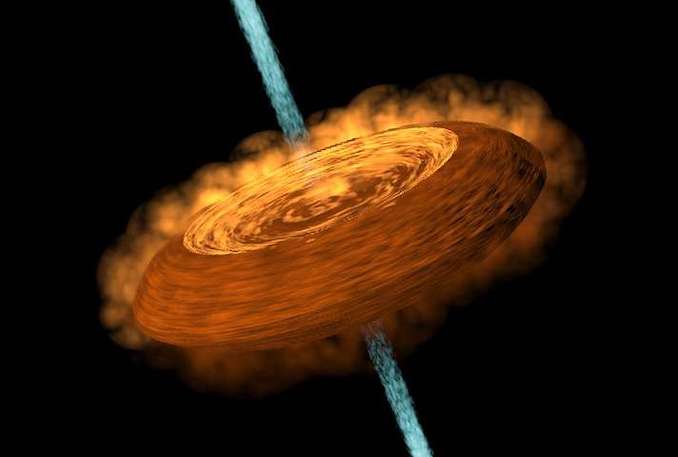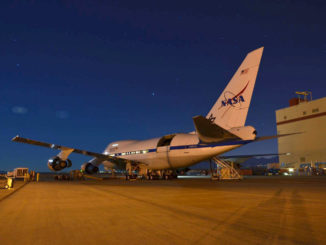A powerful wave of thermal radiation caught rippling through an accretionary disc of gas surrounding a distant protostar could be the strongest evidence yet for how the most massive stars in the Universe form.

The ‘heat wave’ has been observed coming from the protostar G358.93-0.03, which lies 22,000 light years away and currently weighs in at eight times the mass of the Sun, and is still growing. Astronomers led by Ross Burns of the National Astronomical Observatory of Japan, writing in the 13 January issue of Nature Astronomy, believe this pulse of heat to be an outburst from the star after it gobbled up a clump of gas from the disc.
“The thermal pulse is the smoking gun that we’ve seen an episode of intense accretion onto the protostar,” Burns tells Astronomy Now.
As we know, stars are born in the nurseries of clouds of molecular hydrogen gas, which form many of the colourful nebulae visible to our telescopes. Patches of these clouds can collapse under self-gravity, and as they collapse they begin to rotate, with the burgeoning star eventually breaking free as the cloud fragments, resulting in an individual protostar.
That’s not the end of the protostar’s growth. The rotation of the collapsing cloud that bequeathed it causes part of the cloud that remains to flatten around the protostar, creating an accretion disc – a supply of gas with which to feed the growing protostar.
Yet there has always been a problem with our models of how stars from. The lower the mass of a star, the more common it is in the Universe – a property of star formation that we call the ‘stellar mass function’. The lowest mass stars, which we call red dwarfs, can have as little as 7.5 per cent of the mass of the Sun, and make up three-quarters of all stars. On the other hand, the most massive stars, which can be dozens or even hundreds of times more massive than the Sun, are comparatively rare. Yet astronomers do not yet fully understand why the stellar mass function is weighted towards lower mass stars, or why some stars grow so massive when the majority do not.

Growing pains
One of the leading theories as to how massive stars grow describes how these stellar giants experience growth spurts from randomly accreting clumps of matter from the surrounding accretion disc. Yet, actually observing this process is tricky – the star-forming nebulae around protostars is so dense that visible light cannot shine through, and we cannot clearly see what is going on. Instead, astronomers resort to longer-wavelength astronomy, in infrared and radio, which can pass through the gas and dust.
These growth spurts had only been observed on protostars twice before, in 2015–16, when in January 2019 astronomers led by Yoshinori Yonekura of Ibaraki University in Japan, using the 32-metre Hitachi radio telescope, detected the appearance of methanol masers in the disc surrounding G358.93-0.03. Masers are microwave equivalents of lasers, in that they are able to amplify microwaves, but unlike optical lasers, masers can be produced naturally in some astrophysical environments such as star-forming regions, planetary nebulae, even comets, which satisfy a narrow range of conditions including being at the right temperature. In particular, accretion onto protostars seems to be able to drive exotic maser activity – that is, new masers at wavelengths not seen before – in a big way.

With the masers being a strong indication that an episode of accretion had taken place, the results were quickly reported back to the Maser Monitoring Organisation, which is a global community of astronomers, including Burns, who observe masers to study the Universe. Burns assembled a team and planned a follow-up campaign, with radio telescopes in Australia, New Zealand and South Africa all working in unison to create a very long baseline interferometer – basically combining the individual telescopes to give an overall resolution equivalent to that of a radio telescope with an aperture that spans continents. They observed G358.93-0.03 twenty-six days after the initial detection, and found that the emission from the masers had moved outwards from the protostar.
Riding the heat wave
This change in location of the masers could be interpreted in one of two ways. The first is that the methanol molecules have physically moved, but given the distance that they would have travelled – 40 billion kilometres, or 270 astronomical units – this would be unfeasible because moving too fast will cause high-energy collisions between the masers and other molecules, ultimately leading to the masers switching off as their temperature rises. Rather than being seen further from the star, their emission would simply vanish.
Instead, Burns’ team think that the motion of the maser emission is the result of a thermal wave produced by the accretion episode propagating through the disc. As the wave moves radially away from the star, its forward edge creates the conditions to produce masers in molecules of methanol, at temperatures between 100–200 kelvin (–173 to –73 degrees Celsius). Behind the heat wave, the temperature must be greater, which causes the masers there to shut themselves off, only for methanol masers located further from the protostar to become activated once the leading edge of the wave reaches them.
Given the distance covered, the thermal wave must be moving at four per cent of the speed of light. While still quite fast, it is substantially slower than is expected for such a wave. Its relative sluggishness implies that the accretion disc through which the wave is passing is denser than thought, and that the photons within the wave are scattering off the atoms and molecules of gas within the disc, slowing the progress of the wave.
Meanwhile, further evidence for an accretion event comes from infrared observations performed by NASA’s airborne SOFIA (Stratospheric Observatory for Infrared Astronomy) telescope, which detected an increase in infrared luminosity from G358.93-0.03. This was another indication that some kind of outburst following an accretion event had taken place.

How to build a massive star
Things become even more interesting when the G358.93-0.03 accretion event is compared to the two events on other stars seen previously in 2015–16. G358.93-0.03’s outburst had a slightly different signature to the other two – the masers brightened and then disappeared faster in the case of G358.93-0.03, and the infrared luminosity of the event was not as great. These are signs that accretion events that build massive stars are not always the same, and could differ from star to star, or at different periods in the star’s formation.
So it’s clear that more examples of accretion onto massive protostars need to be observed to build up a catalogue of different types of events. Astronomers including Burns, working under the auspices of the Maser Monitoring Organisation, are now busy looking for other examples of this heat wave phenomenon around massive protostars.
“We have found a few more good candidates,” says Burns, “But we’ve not published the results yet.”
As an addendum to the discovery, the thermal wave could also have implications for any planet-forming disc that develops out of the accretion disc. The thermal pulse is able to chemically alter the disc, as evidenced by Burns’ team reporting the appearance of several new exotic masers not seen before in star-forming regions.
“It seems certain that these heat-waves would influence the chemistry of a planet-forming disc,” says Burns. For example, he highlights how the various snow lines – the radius from a star at which various volatile elements, for example, carbon monoxide, carbon dioxide and water vapour, freeze out – might be pushed outwards from the star by the heat waves.
However, in the grand scheme of things, any changes to the chemistry of a planet-forming disc will be short-lived. G358.93-0.03 won’t get much opportunity to form planets, since it is set to explode as a supernova sometime between 10 and 20 million years from now.



